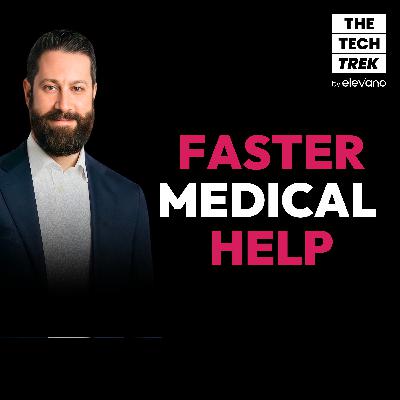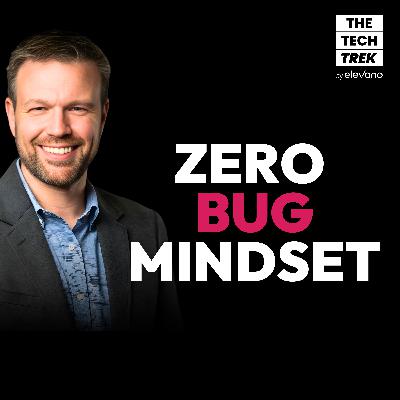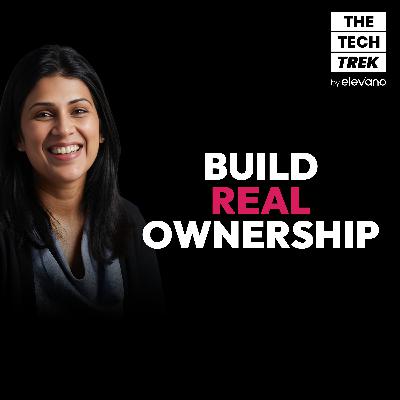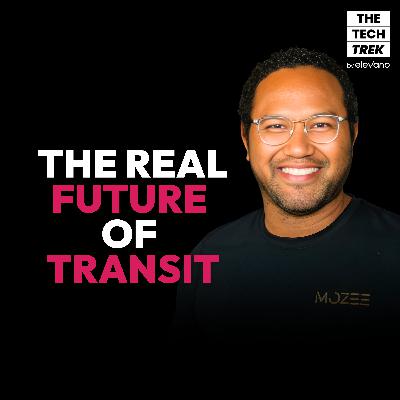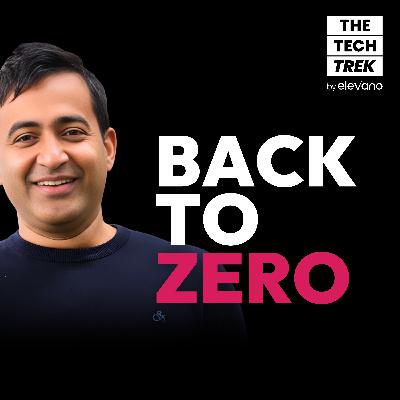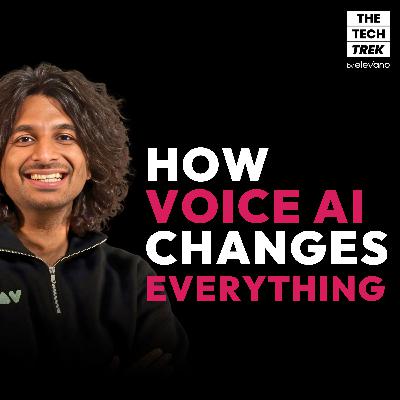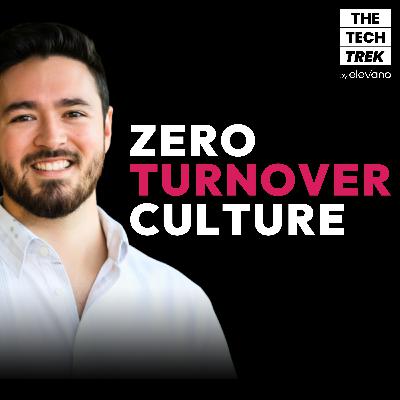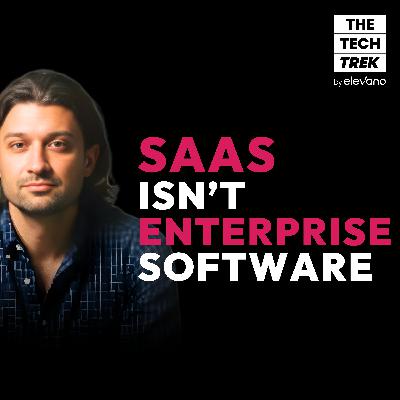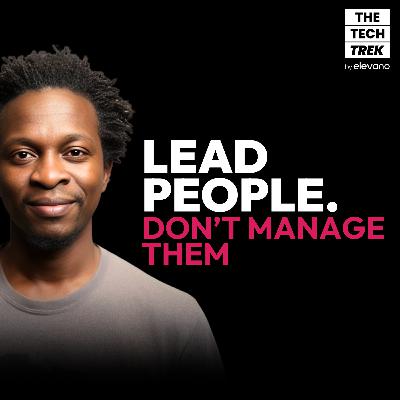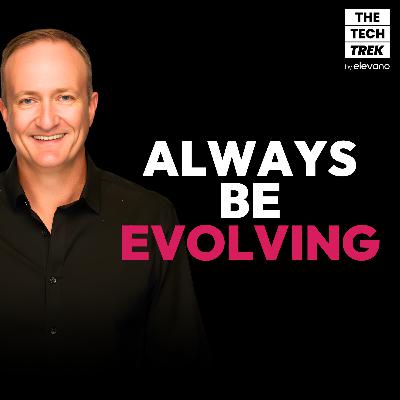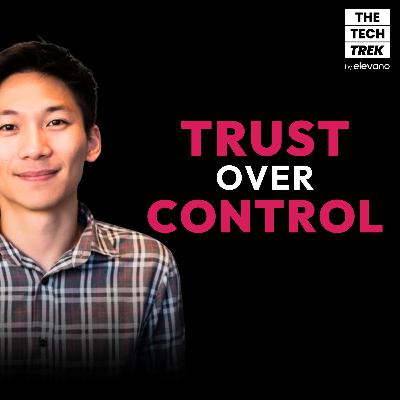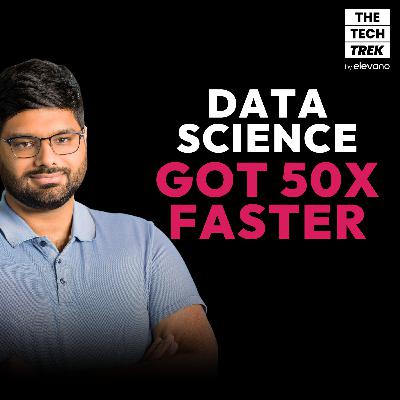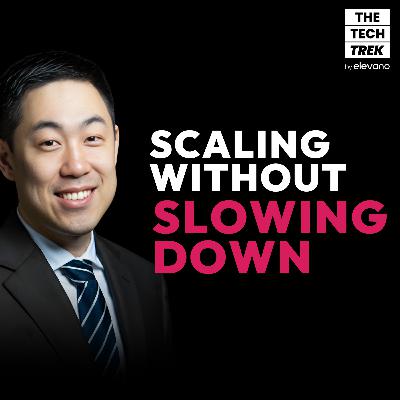Discover The Tech Trek
The Tech Trek

The Tech Trek
Author: Elevano
Subscribed: 10Played: 945Subscribe
Share
© Elevano
Description
The Tech Trek explores how engineering leaders build teams that deliver real outcomes. The show looks at the connection between people, impact, and technology, and how that relationship is changing fast with data and AI now at the center of every product and company.
Hosted by Amir Bormand, founder of Elevano, the show features CTOs, VPs of Engineering, heads of data, and technical leaders who have built and scaled teams in high pressure environments. They share the decisions that shaped their path, the experiments that worked, and the thinking they rely on to stay ahead in a world defined by
Hosted by Amir Bormand, founder of Elevano, the show features CTOs, VPs of Engineering, heads of data, and technical leaders who have built and scaled teams in high pressure environments. They share the decisions that shaped their path, the experiments that worked, and the thinking they rely on to stay ahead in a world defined by
574 Episodes
Reverse
Most people still think of AI in medicine as a novelty. Matt Pavelle sees it as the new first step in patient care.In this episode, Matt breaks down how Doctronic built an AI doctor that can gather history, follow clinical guidelines, produce full treatment plans, and then hand everything to a real physician who can review it in minutes. It is private by default, aligned with top primary care doctors, and already helping millions of people move faster through the healthcare system without lowering the standard of care.We talk through how this changes access, trust, and the way care teams work. And we open up what this means for the future of primary care as capacity continues to fall and patient demand keeps rising.Key takeaways• The AI is trained on physician written clinical guidelines which gives it a clear path for gathering symptoms, sorting possible conditions, and building treatment plans that match top doctors at a high rate.• Privacy and trust were built in from the start. The chat is anonymous, data is not used for training, and everything is run with HIPAA level protection even when it is not required.• Capacity pressure is the real problem in primary care. Offloading the easy eighty percent of cases lets doctors focus on the harder ones and gives them more time with each patient.• The system writes notes, gathers history, and completes insurance paperwork which cuts down on burnout and improves the patient experience.• This model can scale to wearables, home devices, labs, and specialists which could raise the standard of care for people who normally wait weeks for answers.Timestamped highlights00:40 Doctronic explained and why a full visit can take only a few minutes03:44 How medical knowledge moved from books and search results to AI that can guide real care08:13 A look at the micro agent system and how the team measures accuracy against real doctors11:27 The shortage of primary care doctors and why capacity pressures make AI support necessary17:20 How anonymous design and strong privacy choices help people trust the system26:05 Adoption numbers, fast growth, and what millions of consults are teaching the teamA line that captures the episodeWe want to be that first step in patient care every time you need that first step.Pro tips for builders and leaders• Ground your product in real domain guidelines so the AI follows the same reasoning paths as experts.• Treat privacy as a design choice. Make it clear, simple, and part of the value of the product.• Focus on the work that slows experts down. The biggest wins come from reducing the load, not from replacing the expert.• Make the handoff between AI and human seamless so the expert starts with context instead of starting over.Closing noteIf you enjoyed this conversation, follow The Tech Trek, leave a quick rating, and share this episode with someone curious about the future of patient care and AI.
Chris Church, VP of Engineering at Rainforest, breaks down why a zero bug policy is more than a technical choice. It is a mindset, an operating model, and a culture shift that shapes how engineering teams build, release, and support software at scale.In this conversation he goes inside the habits that actually make quality a strategic advantage and explains how small releases, strong visibility, and healthy engineering practices create real impact over time.Key Takeaways• Quality is not a feature. It is the foundation of trust, especially in a payments environment where even small defects can erode confidence.• Small releases reduce risk because teams can actually reason about the changes they ship. Frequency builds confidence and reliability.• Visibility is non negotiable. You cannot fix what you cannot see, so strong monitoring and clear alerts must exist before a quality culture can grow.• Teams need real capacity set aside for fixes and improvements. Without that buffer, bugs turn into a silent tax that slows down the entire org.• You can adopt a zero bug mentality even in a mature codebase, but you must commit to a long game of continuous improvement.Timestamped Highlights00:33What Rainforest actually does and why their customers rely on embedded payments01:44Chris explains what a zero bug policy means in practice for a fintech engineering team03:06Why the policy must be strict and why a backlog of broken things creates a false sense of safety06:13How Rainforest structures ownership, on call rotations, and incident response to support quality10:51Smaller releases, lower risk, and why the size of a change has a direct impact on failure modes12:59Why test coverage and automation must start early and why teams struggle when they try to catch up later14:27How to adopt this mindset if your org is nowhere near zero bugs and where to begin23:44The biggest gotchas teams underestimate when they start this journey and why progress requires patienceOne line that stands out“People overestimate what they can fix quickly and underestimate what they can improve over the long run.”Pro Tips• Start by making your system noisy. More visibility will feel painful at first, but it becomes the foundation for every improvement.• Reserve capacity for fixes before planning feature work. If you wait until later, that time will never appear.• Break tech debt into specific problems. Vague labels hide real risks and slow down prioritization.Call to ActionIf you found value in this conversation, follow the show and share it with someone who cares about engineering quality, team culture, and building software that lasts. You can also connect with me on LinkedIn for more conversations that explore people, impact, and technology.
Snehal Antani, co founder and CEO of Horizon3 AI, joins the show for a conversation about how veterans bring rare leadership strengths to fast moving companies. He pulls back the curtain on the world of special operations, shares what industry leaders often miss when interviewing former service members, and explains why these leaders are some of the most prepared problem solvers you can hire.This episode helps any listener understand the real strengths behind military experience and how those strengths translate into modern tech and business environments.Key Takeaways• Veterans succeed in high pressure environments because they train as learn it alls and solve problems as a team• The best performing military units succeed due to empowerment, shared understanding, and clear cadence• Many veterans underestimate their own leadership ability when entering industry and need support reframing their experience• Hiring managers often miss top talent because they use filters that do not map well to military backgrounds• Reference based hiring and early transition planning create a smoother path for veterans entering tech rolesTimestamped Highlights00:41 Snehal describes the world inside JSOC and what makes special operations leaders exceptional04:45 Why many transitioning service members experience imposter syndrome and how to shift that mindset10:17 How geography affects familiarity with military culture and shapes hiring outcomes14:33 A look at why Israeli veterans become top founders and what the United States can learn from that19:19 How military roles connect directly to major sectors like logistics, telecom, infrastructure, and talent management24:24 The real reason many veterans struggle to land interviews and why referral networks matter so much28:40 Practical resources and programs that help veterans navigate transition with clarity and confidenceA line that captures the heart of the episode“You are the most cycle tested leader in the world. Those skills are not taught in school. They are earned.”Practical advice from the conversation• Translate military jargon into industry language and speak to the business outcomes you created• Build and maintain a strong network long before you transition• Start planning two to three years out and use programs like SkillBridge to build experience and confidence• Hiring teams should look beyond titles and focus on the pressure tested leadership traits that veterans bringCall to actionIf this conversation helped you, follow the show and share the episode with someone who would benefit. You can also connect with us on LinkedIn for more leadership insights and real stories from people shaping tech today.
Chandni Jain, VP of Engineering at Checkr, joins the show to talk about what it takes to build a real culture of ownership. She explains how clarity, trust, and true empowerment help teams move faster and work better together. You will also hear how leaders can bring out stronger initiative and confidence in their people.This episode gives a simple and useful guide for anyone who wants to lead with intent and build teams that think and act like owners.Key Takeaways• Ownership grows when clarity, context, and empowerment all work together• Strong accountability does not require fear. It comes from trust and clear expectations• Teams follow what leaders show, so leaders need to model ownership every day• Feedback works only when trust comes first• New managers grow fastest when they balance technical skills with people leadershipTimestamped Highlights00:26 Why ownership begins with customer outcomes02:02 How accountability, empowerment, and safety support each other04:08 The difference between blame and real accountability11:36 How to give people space to lead without losing direction14:37 What new managers struggle with and how to guide them16:49 A four part checklist for building stronger ownership20:16 Why recognition matters and how it lifts the whole orgA standout moment“Ownership begins with you as a leader. The team mirrors what they see.”Pro Tips• Give clear context early and often so people know what they own• Celebrate small wins to encourage more initiative• Focus on outcomes, not tasks. It changes how people think and deliver• When someone steps up, give them more room to growCall to ActionIf this episode helped you see leadership and ownership in a new way, follow the show and share it with someone who might find it useful. For more conversations on people, impact, and technology, subscribe and stay connected.
Shawn Taikratoke, CEO and co founder of Mozee, joins the show to unpack one of the biggest questions in mobility today. How close are we to real autonomous transportation and what will actually move the needle in our cities. Shawn breaks down why the future is not a single robotaxi dream, but a more human centered shift in public transit that solves the first and last mile in a smarter way. If you care about how people move, how cities evolve, or how autonomy will reshape everyday life, this one is worth your time.Key Takeaways• The biggest transportation barriers are not technical. They come from how cities were built and how people actually move in short distances.• Robo taxis will play a role, but public transit needs a more flexible and human centered model before adoption changes.• Many Americans still have no access to reliable transit, which creates ripple effects in work, health, and community access.• Real adoption will come when mobility becomes easier and cheaper than using your own car.• Cities want smarter transit, but they need partners that help them bridge gaps without major infrastructure costs.Timestamped Highlights00:44 What Mozee was built to solve and why they avoided the pure robotaxi route03:26 Why autonomy still scares most people and how public perception is shaping rollout06:57 How regional culture and city layout shape transportation adoption10:24 The vision for a mesh network of shared autonomous shuttles16:24 How smarter first mile and last mile service can shift car dependence21:52 What it takes to move from a handful of vehicles to true scale27:54 Why Shawn moved from the robotaxi hype to solving public transit gaps insteadA standout thought“Progress is rarely a straight line. The products that last are the ones that stay human centered.”Pro Tips from the Conversation• Transit solutions that work do not start with tech. They start with how people move in the real world.• Scale only matters when it meaningfully makes someone’s day easier.• If you want to understand mobility problems, talk to city officials. They know exactly where the gaps are.Call to ActionIf this episode pushed your thinking about mobility and smart cities, follow the show and share it with someone who is curious about the future of how we move. New episodes every week with leaders shaping technology, people, and impact.
Mike Hanson, CTO at Clockwise, joins the show to break down how our relationship with computers is changing as language based systems reshape expectations. We explore why natural storytelling feels so intuitive with today’s AI tools, how context is becoming the new currency of great software, and why narrow AI is often more powerful than the industry hype suggests.This conversation gives tech leaders a grounded look at what is real, what is noise, and what is coming fast.Key Takeaways• Natural storytelling is becoming the default way people communicate with AI, and products must adjust to that shift.• Context is the driving force behind great interaction design and LLM powered systems now surface and use context at a scale traditional UIs never could.• Most real world gains come from narrow AI that solves focused everyday problems, not from broad AGI promises.• Multi agent systems and multiplayer coordination are emerging as the next frontier for enterprise AI.• The biggest risk is not model weakness but user uncertainty about when an answer is trustworthy.Timestamped Highlights01:21 What Clockwise is building with its scheduling brain and how natural language creates new value04:13 Why humans default to storytelling and how LLMs finally make that instinct useful08:00 The rising expectation that software should understand context the way people do12:13 The shift away from feed centric design and toward multi person coordination in AI systems17:31 Why narrow AI delivers real value while wide AI often creates anxiety23:52 A real world example of how AI can remove busy work by orchestrating tasks across tools26:24 Why we do not need AGI to meaningfully improve everyday productivityA standout thoughtPeople have always tried to talk to computers in a natural way. The difference now is that the systems finally understand us well enough to meet us where we already are.Pro Tips• Look for AI that reduces busy work across tools rather than chasing broad capability.• Prioritize context rich interactions in your product planning. It will define user expectations for years to come.• Treat multi person workflows as the next major opportunity. Most teams still rely on manual coordination.Call to actionIf this episode helped you think differently about where AI is actually useful, follow the show and share it with someone who is building product in this space. And join me on LinkedIn for weekly insights on tech, people, and impact.
Soham Mazumdar, CEO and co founder of Wisdom AI, joins the show to talk about what it really takes to build again after major exits at Facebook and Rubrik. We get into the mindset shift required for a new startup, the danger of relying too much on past playbooks, and how to stay grounded when expectations rise.If you want a real look at repeat founder decision making, this is the conversation to listen to.Key Takeaways• The biggest advantage of being a repeat founder is the ability to attract talent and early believers, but it does not replace the need for fresh thinking.• Pattern matching can help with people decisions but can block you everywhere else if you assume the past will repeat.• Feedback can steer you or mislead you. The real work is separating patterns from outliers and understanding the motivation behind what someone says.• Every new company pulls you back to zero. Past success does not win customers or validate your idea.• Early career operators who want to build should leap sooner than later. Even a failed startup can shape a long career.Timestamped Highlights02:01 How building tactile and Rubrik shaped his approach to Wisdom AI04:07 What actually drives someone to found a company after a giant exit05:52 Why repeat founders must fight the urge to reuse old playbooks10:06 How to course correct when your first instincts are wrong13:38 The danger of reacting too fast or too slow to customer feedback18:02 How expectations shift once you have a track record24:42 Why Wisdom AI connected with his earliest experiences at Google25:28 The advice he wishes someone had given him before startup number oneA standout line“The world pulls you down to the ground fast. Whatever you think you are, a new company reminds you that none of it matters unless you execute.”Practical advice from the conversation• Do not treat feedback as instructions. Treat it as signal to study. Look for repeated patterns, not one loud voice.• Approach every new company with a clean mind. If your old patterns do not match the new environment, abandon them quickly.• Think of your career as a long arc. Early risks create unexpected doors later.Closing noteIf the episode gave you something to think about, follow the show and share it with someone who wants a real look at the founder journey. You can also join the community on LinkedIn for more insights and upcoming episodes.
In this episode of The Tech Trek, Amir sits down with Sadi Khan, Co-Founder and CEO of Aven, to unpack how technology can make capital fairer for everyone. Sadi explains how Aven is tackling one of the world’s biggest inefficiencies—the trillion-dollar burden of consumer credit card debt—and why the solution lies in reducing the cost of capital through innovation. This is a deep dive into building products that require not just engineering skill, but endurance, conviction, and a long-term mindset.Key Takeaways• Aven’s mission is to cut credit card interest payments in half by rethinking how consumers access and use home equity.• True innovation often comes from solving inefficiency, not chasing market trends.• Complex problems create strong moats when founders are willing to grind through technical and regulatory barriers.• Founders should pick problems worth spending a decade on—pivot less, persist more.• Product success depends on identifying your “axis” and going all-in on being the best at that one thing.Timestamped Highlights00:40 — How Aven’s hybrid credit card + HELOC model is lowering the cost of borrowing for homeowners04:10 — The moment Sadi realized the cost of capital was a massive, overlooked problem12:34 — Why most lenders haven’t solved this yet and how Aven’s approach differs19:33 — Building what others couldn’t: how persistence and engineering precision led to breakthroughs23:36 — Choosing execution risk over market risk and what it takes to stay with a problem long enough to solve it37:47 — Why picking the right “axis” is how great companies build an unshakable moatMemorable Line“The only problems worth working on are the ones worth working on for a very long time.”Call to ActionIf you enjoyed this episode, follow The Tech Trek for more conversations at the intersection of people, impact, and technology. Subscribe on your favorite platform and share it with someone building bold ideas.
Svetlana Zavelskaya, Head of Software Engineering for Data Platform and Infrastructure at Quanata, joins the show to unpack what it really takes to make the “impossible” possible in tech. From re-architecting a startup codebase to scaling innovation inside an insurance giant, she shares how her team turns complex R&D challenges into production-ready systems. This conversation dives deep into engineering discipline, AI tool adoption, and why the next wave of insurance innovation is powered by data and software.Key Takeaways• Real innovation often means balancing speed with long-term architecture decisions• AI coding tools are valuable for exploration but need governance and clear security guardrails• POCs fail when expectations aren’t aligned, not because the tech doesn’t work• Insurance tech is evolving fast through telematics and context-based data models• Well-structured, well-documented code is still the foundation for scalable innovationTimestamped Highlights00:33 How telematics is changing the economics of insurance and rewarding better drivers03:59 Cars as software platforms and what that means for data privacy and innovation06:02 The growing pains of re-architecting an organically built startup codebase08:38 Evaluating new AI tools and maintaining data security across teams11:08 Why most AI POCs never make it to production16:29 How Quanata’s R&D work feeds into State Farm’s larger technology initiatives20:40 Safe-driving challenges, behavioral change, and saving lives with dataA Thought That Stuck“If we can prevent just 1 percent of drivers in the world from using their phone behind the wheel, imagine how many lives we can save.”Pro Tips• Before starting a POC, define if it’s an experiment or a potential product foundation• Let engineers explore new tools but build frameworks to govern how data and results are handledCall to ActionIf you enjoy exploring how data, AI, and engineering innovation come together to solve real-world problems, follow The Tech Trek on Apple Podcasts or Spotify and share this episode with a colleague who builds at the edge of what’s possible.
Nikhil Gupta, founder and CTO of Vapi, joins Amir to talk about how voice AI is reshaping the way we connect with businesses. From customer support to healthcare, Nikhil explains how voice agents can bring back the human side of digital interactions. This is a look at where real conversation meets real technology and what happens when machines start to understand us like people do.Key Takeaways• Voice AI creates genuine, human-like engagement instead of the usual scripted support.• The next wave of AI will personalize relationships at scale while protecting privacy.• Full duplex voice models will make conversations flow naturally and feel real.• Businesses will use voice agents to understand customers, not just respond to them.• Our phones and screens may evolve as voice becomes the primary interface.Timestamped Highlights01:08 — What Vapi does and how it reached 400,000 developers02:15 — Why voice AI is one of the few areas showing clear ROI06:09 — How AI can make customer relationships human again11:18 — Building trust and privacy into voice-based systems16:48 — Blending text, voice, and context into a single experience19:05 — Rethinking our devices as voice replaces the screenA moment that stands out“Every person should feel like they can just text their hospital, and it knows exactly who they are, what they need, and when to help.” — Nikhil GuptaPro TipStart small. Use voice AI where conversation improves experience or clarity. It’s not about automation; it’s about creating connection.Call to ActionShare this episode with someone exploring AI in their business and follow The Tech Trek for more stories about people, impact, and technology.
Alex Daniels, Founder and CTO at Predoc, joins the show to share how he is building a mission driven healthtech company that is changing how medical data is accessed and used. He opens up about the personal story that inspired Predoc, how he keeps culture authentic while scaling, and what zero turnover really looks like in a startup. From hiring philosophies to equity design to managing context switching, Alex brings a deeply human view of leadership in engineering.Key Takeaways• Building culture starts with personal connection. Founders who share their why help every new hire connect to mission and meaning.• The best hiring filters are values and networks, not just tech stack alignment.• Predoc’s culture formula of high agency, urgency, meritocracy, and transparency keeps turnover at zero.• Equity is not just compensation. It is shared ownership and long term motivation.• Flat structures and super ICs can scale effectively when leaders stay close to the work.Timestamped Highlights[01:30] How a personal loss and a lifelong heart condition inspired Predoc’s mission to fix healthcare data[05:20] Inside Predoc’s culture formula and why it has helped them retain every hire for three years[09:40] Why core values stay constant but merit evolves as the company grows[13:00] Rethinking equity and risk for early startup employees[15:10] How Predoc combats AI assisted interview cheating and keeps hiring authentic[23:45] Building a flat team structure where directors are still super ICs[30:00] Alex’s approach to managing context switching and mental decompressionMemorable Line“We cared about what he cared about and why would he care about what we care about if I don’t care about him?”Call to ActionIf you enjoyed this conversation, follow The Tech Trek for more candid talks with founders and tech leaders shaping the future of engineering and culture. Subscribe on Spotify or Apple Podcasts and join the discussion on LinkedIn.
Jordan Tigani, CEO and cofounder of MotherDuck, knows what world class infrastructure looks like. He spent years building Google BigQuery before taking those lessons into the startup world. In this episode, he breaks down why building infrastructure products is fundamentally different from typical SaaS and why founders who don’t understand that difference are in for a painful surprise.What You'll LearnThere are no shortcuts in infrastructure. You can’t just wire together existing open source components and call it a product. Real infrastructure requires contributing meaningfully to the state of the art, and that takes time, money, and deeper technical investment than most founders expect.Starting with startups, not enterprises, is often the smarter play. Early stage infrastructure companies should target other startups first because they’re more comfortable with bleeding edge tech, have lower security barriers, and won’t force you to spend three engineers building custom auth instead of your actual product.Scaling down is the new scaling up. Jordan saw pressure at SingleStore to make databases smaller and more efficient, not just bigger. That insight led to MotherDuck, which is built on DuckDB—a database that can run in a car, scale to massive cloud instances, and challenge the coordination overhead of legacy distributed systems.Bottoms up engineering cultures win in infrastructure. At BigQuery, engineers close to customer problems could ship fast and independently. Jordan’s recreating that at MotherDuck by removing layers between engineers and customers, because creative problem solving requires understanding business constraints, not just technical ones.Convincing people you can scale is half the battle. The best proof is customers who look like your next target and can vouch for you. Next best is real data and benchmarks. If you don’t have those yet, lean on implementation support and help prospects test at scale themselves. Early on, sometimes all you have is your word.Timestamped Highlights[01:22] Why infrastructure takes longer to build than typical SaaS products and why there’s no shallow way to do it[06:57] The MVP dilemma: finding product market fit when enterprises demand reliability from day one[11:44] Lessons from BigQuery and SingleStore—what to carry over from big tech and what to leave behind[21:21] The gap in the market that led to MotherDuck: why distributed databases don’t scale down and why that matters now[26:10] Redefining scale: why 100 users on one giant instance isn’t necessarily better than 100 auto scaling individual instances[29:08] The hierarchy of proof: from customer testimonials to benchmarks to trust me, it’ll workA Line to Remember“If you really want to build an infrastructure product, you can’t just string existing components together. You actually have to contribute meaningfully to improving the state of the art.”Stay ConnectedIf this breakdown of infrastructure startups resonated with you, subscribe so you don’t miss future episodes. And if you’re building in this space or thinking about it, connect with Jordan on LinkedIn. He’s committed to paying forward the help he got as a founder.
Ogi Kavazovic, co-founder and CEO of House Rx, joins the show to unpack what most product leaders miss about building for enterprise software. Drawing from two decades in tech, Ogi breaks down how product management shifts when you move from B2C or “B to small B” to true enterprise—what he calls “B to Big B.” He explains why traditional user research frameworks don’t hold up, how buyer research should actually be done through sales and marketing motions, and how to keep engineering teams aligned when the product takes years to build.Key Takeaways• Building for enterprise (B to Big B) requires selling to buyers and users—two very different audiences with distinct needs.• Buyer research is not user research—it happens through early sales decks, vision slides, and iterative storytelling that test how well a concept resonates before code is written.• Pre-selling a “fantasy product” through slides helps validate the market fit and shapes the first version of your product strategy.• Engineering for enterprise software demands simulated iteration—testing features internally long before the MVP is complete.• Vision alignment between product, marketing, and engineering is crucial to avoid two-year build tunnels and ensure team motivation.Timestamped Highlights[03:12] The overlooked divide between B2B and true enterprise—why “B to Big B” changes everything for product teams.[10:47] How buyer research actually works and why it starts with slides, not software.[17:40] The difference between pitching VCs and pitching enterprise buyers—and why they care about totally different things.[22:29] The engineering challenge of building massive enterprise systems and why agile methods fall short.[30:11] How to keep teams motivated and moving forward when the product roadmap spans years.Standout Moment“You can pre-sell a product before it even exists. That sales and marketing artifact—the deck you built to sell your vision—can become the blueprint for your product strategy.”Pro TipsStart with conversations, not code. Use early customer and buyer meetings to validate your story through slides, then hand your engineers a vision they know can sell.Call to ActionIf you enjoyed this episode, share it with a fellow product leader or founder navigating enterprise challenges. Follow The Tech Trek for more conversations that connect people, impact, and technology.
Astasia Myers, General Partner at Felicis, breaks down how venture capital is betting on AI and why over 80% of their recent investments are in this space. But this isn’t just another “AI is the future” conversation. We dig into the real ROI happening right now in healthcare voice agents, why MIT says 95% of GenAI projects fail to reach production, and what needs to happen for that number to flip. If you’re building, investing, or just trying to understand where enterprise AI is actually working (not just hyped), this episode cuts through the noise.What You'll LearnThe labor replacement opportunity: Why outcome-based AI solutions are targeting the $35 trillion labor market instead of just software budgets and how that changes everything for startups and investors.Voice AI’s healthcare breakthrough: How voice agents are finally solving the operational bottlenecks in patient scheduling and communication, driving 24/7 availability with better NPS than human operators.Why 95% of GenAI projects still fail: The technical and infrastructure gaps that prevent most AI initiatives from making it to production and what’s needed to fix that in 2026.The new technical risk era: After years of focusing purely on market risk, VCs are back to evaluating deep technical challenges in agentic systems, browser automation, and continuous learning loops.The exceptionalism filter: How early-stage investors are separating signal from noise when everyone can spin up an AI startup and why founder insights and lived experience matter more than ever.Timestamped Highlights00:31 – What Felicis invests in and the types of AI companies dominating their portfolio right now02:58 – Why healthcare tech is finally ready for its AI moment after years of long sales cycles and unclear ROI08:15 – How outcome-based pricing is changing the VC evaluation playbook and unlocking 10x larger TAMs13:26 – The mythical one-person billion-dollar company: Is it real, and how would investors even spot it?17:18 – Voice AI as the gateway for enterprise adoption and why this modality is different from Siri and Alexa20:08 – Democratizing AI: What ChatGPT did for consumers and what needs to happen for enterprise buildersOne Thing Worth Remembering“These technologies can price towards the labor replacement markets, which is about 10x the size of the software market itself. The ROI right now is so tangible that it is a time to invest.”Subscribe and Stay in the LoopIf this episode gave you a new angle on where AI is actually delivering value, share it with a founder or investor who needs to hear it. Subscribe so you don’t miss the next conversation, and drop a comment if there’s a topic or guest you want us to tackle next.
In this episode, Amir sits down with Taofeek Rabiu, VP of Engineering at Etsy, to unpack a distinction that most organizations miss: being a people leader is not the same as being a people manager.If you have ever wondered why some teams thrive under pressure while others crumble, or why trust feels so hard to build in engineering orgs, this conversation has answers. Taofeek shares how leadership is not reserved for those with a manager title, why vulnerability is a strategic advantage, and how to spot the early warning signs of poor leadership before they drag down performance.What You’ll LearnLeadership exists at every level, not just in management roles. Individual contributors who mentor, influence, and model the right behaviors are leaders too — and organizations need to recognize and reward that.Trust is built through action, not talk. It grows when leaders show vulnerability, stay transparent about their thinking, and follow through on commitments. When you stop acting on what you hear, you break trust.Poor leadership has a smell. Teams that avoid hard conversations, struggle to navigate change, or fail to ramp new hires are showing symptoms of leadership gaps, not process problems.Feedback is about helping people see, not telling them what to do. The best leaders use curiosity to guide others toward realization and self-awareness.Effective leaders make high signal, low frequency decisions. The goal is not to make a thousand calls a day but to gather diverse perspectives and make the few decisions that truly move the team forward.Timestamped Highlights01:42 – Taofeek breaks down the difference between managing people (reviews, org charts, timesheets) and leading people (building trust, showing care, creating psychological safety).09:04 – What happens when managers focus only on mechanics. Taofeek describes the smells of poor leadership and how they surface in teams that can’t handle change.13:18 – How to give feedback when someone is not showing up as a leader. Taofeek explains his approach: start with curiosity, triangulate with skip levels, and guide people to their own realizations.17:47 – Who is responsible for building trust. Taofeek shares why it is on leaders to create the conditions, not on reports to earn it.22:04 – The moment Simon Sinek told Taofeek to stop saying people managers and start saying people leaders — and how that small shift in language changed his approach to leadership.24:29 – What feedback a VP of Engineering actually values. Taofeek shares how he uncovers blind spots and the kind of input that helps him grow.Words That Stuck“The team doesn’t trust you. You’re not providing a psychologically safe environment in which the team feels like they can course correct and flag things that they believe will lead to poor outcomes.”If This Resonates, Here’s What to DoTake one insight from this episode and put it into practice this week. Maybe it’s being more open in your next one-on-one, checking your follow-through, or asking your team a question you have been avoiding. Then share this episode with someone navigating the manager-to-leader transition. Subscribe to The Tech Trek for more conversations that help you grow as a leader, and connect with Taofeek on LinkedIn to keep the dialogue going.
Ion Feldman, CTO at Rightway, has learned to love one thing about scaling a company from a kitchen table to nearly 1,000 employees: his job completely changes every six months. In this episode, Ion shares what it means to lead engineering when the role refuses to stay still—from writing code in the early days to building product, security, and data teams, and now shaping AI infrastructure. He explains how to stay hands-on without micromanaging, why he deliberately works himself out of roles by hiring people better than him, and how to preserve startup urgency inside a heavily regulated industry. If you’ve ever wondered how CTOs balance technical depth with business strategy while keeping their team fast and focused, this conversation delivers.Key TakeawaysTreat change as part of the job.Ion’s leadership mindset centers on adapting to wherever the company needs him most—product, security, data, or AI. He views change as an opportunity to grow, not a disruption to avoid.Hire yourself out of the role.He dives deep into an area, builds it from scratch, then brings in experts who can take it to the next level. Once the right leadership is in place, he steps back completely and lets them own it.Hands-on time creates credibility.Ion makes sure every leader spends time building. Each quarter, his team takes a week off from meetings and Slack to focus on creating something new. It keeps them close to the work and sharp as technical leaders.AI adoption needs clarity and focus.Rightway avoids vague “use AI” goals by targeting clear use cases like unit test generation and onboarding to codebases. Sharing examples and results drives faster adoption than leaving teams to figure it out alone.Fail fast and move forward.Ion builds space for experimentation but expects quick recognition of failure. The goal is not to avoid mistakes but to learn, pivot, and evolve faster.Timestamped Highlights[02:10] The zero to one mindset – Why Ion thrives on constant reinvention and the satisfaction of building new functions from the ground up.[06:41] Three pillars of AI strategy – How Rightway is transforming work through AI enablement, applied projects, and bold experiments.[08:26] Delegating by design – How going deep before handing off creates clarity and trust across teams.[15:42] Skills that matter later – Ion reflects on learning public speaking and business fluency after years of technical focus.[17:48] Creating space for risk – How to give your team agency to take on big challenges and fail fast without fear.[21:22] Preparing successors – Why the best leaders hire people who will replace them and rethink everything they built.What Stuck With Us"I don't know, maybe I just get bored easily. I think a lot of people could view it as a burden and they want to stay in their lane of expertise, but I see it as an opportunity to learn and change things up."Pro Tips for Tech LeadersTake a week each quarter to build something with zero meetings or Slack. It reconnects you and your team with what you actually love about engineering.Wait to hire senior leadership until the need is undeniable. The role becomes meaningful, and you’ll attract higher caliber talent.Give your engineers specific AI examples and let them experiment from there. Adoption follows clarity, not mandates.
Jay Chia, cofounder of Eventual, joins the show to unpack what real empowerment looks like inside a fast growing startup. Most people confuse empowerment with initiative, but Jay explains how trust, vulnerability, and accountability work together to turn good teams into self directed ones. If you are scaling a startup or leading a growing engineering team, this conversation explores the human side of leadership, when to let go, when to step in, and how to help your team grow without losing alignment.What You’ll Learn• Why initiative and empowerment are different and how that distinction shapes your company culture• How to build trust so early employees can take ownership without constant oversight• Why vulnerability is the key to honest feedback and deeper one on ones• How to build a culture of experimentation that rewards progress, not perfection• When to intervene as a leader versus when to let your team learn through mistakesTimestamped Highlights03:20 The difference between taking initiative and true empowerment, and why fixing bugs is not ownership08:39 Using vulnerability to turn one on ones into real conversations12:20 Building an experimentation culture inspired by research driven teams17:53 How much room to give before stepping in, balancing trust, skill, and risk21:41 Why letting new managers bring their own cultural imprint can strengthen your companyA Line That Sticks“Empowerment is handing off the monkey. It is not just fixing the problem, it is owning the plan, asking for resources, and having the mandate to execute.”Practical Advice for Leaders• Start one on ones by being open first so your team feels safe to share what is really happening• Lower the barrier to experimentation and let people test ideas early. Progress beats polish• Build rituals, not just processes. Repetition creates trust and space for feedback• Encourage a mindset of asking for forgiveness, not permission. Autonomy grows from trustKeep the Conversation GoingIf this episode made you rethink how you empower your team, share it with another founder or manager who is building through similar challenges. Follow The Tech Trek for more conversations at the intersection of people, impact, and technology.
Rohan Kodialam, cofounder and CEO of Sphinx, is building AI agents that treat data as its own language—one most models and humans still fail to understand. In this episode, he unpacks why data science has lagged behind software engineering, how AI can finally close the gap between business questions and answers, and what happens when small teams gain the analytical power of a thousand person quant desk.What You'll Learn• How AI models that actually see data can unlock insights traditional transformers miss• Why enterprises must rethink dashboards and embrace real time ad hoc analysis• Where AI truly saves the most time across the data lifecycle and why modeling is not the hardest part• How decoupling statistics from business context gives teams freedom to focus on strategy and creativity• Why success in data science now means reclaiming human creativity while automating repetitive workTimestamped Highlights[01:44] Why data is fundamentally different from text and code and why most AI models struggle with it[06:39] The cultural problem with ad hoc being a dirty word in enterprises and why that mindset is changing[11:09] Where AI tools actually fit into the data science workflow[17:09] How to measure success when using an AI data scientist[21:04] What happens when a small team gains the data firepower of a hedge fund quant operation[24:37] Why bad data science is worse than none and why quality matters more than hypeA Thought That Stuck With Us“We are cutting the time to completion by 20x, 40x, even 50x and that remaining human review is not a bottleneck. It is the feature that keeps AI accountable.”Worth FollowingConnect with Rohan Kodialam on X (@KodialamRo) or LinkedIn and learn more about Sphinx AI and how they are transforming enterprise data science.If This ResonatedShare this with someone in the data world who is tired of waiting weeks for insights that should take minutes. Follow The Tech Trek for more conversations about how people and technology create lasting impact.
Karl Alomar, Managing Partner at M13 and former COO of DigitalOcean, joins The Tech Trek to share how being an operator changes the way you invest. He explains why M13 was built to be a truly founder-first VC firm—one that acts early, helps proactively, and builds deep relationships rooted in empathy and experience. From spotting great founders to balancing instinct and data, this episode explores how venture capital can drive better outcomes when it focuses on people as much as product.Key Takeaways• The most effective VCs act before problems surface, shaping a founder’s path rather than reacting to it.• Founder–market fit often comes down to whether someone is a specialist with deep expertise or an athlete who can adapt fast.• Empathy built through years of operating experience creates trust that fuels honest conversations and better decisions.• Great founders lead with vision—they can inspire, recruit, and align teams behind a clear story of what’s possible.• Even the best instincts and pattern recognition can’t outplay timing, luck, and market shifts—but reflection and learning can.Timestamped Highlights(01:20) How being an operator shaped Karl’s approach to venture capital(06:48) The three kinds of investors—and why empathy gives operators an edge(09:54) Creating a safe space where founders can share problems without fear(14:13) Identifying “athletes” and “specialists” when evaluating founders(20:33) Pattern matching, instincts, and the role of luck in investing(23:50) What M13 learns from postmortems on both wins and missesA Line That Stuck“To do it the right way, you have to be a proactive investor, not a reactive one.”Pro TipsKarl suggests founders build relationships with investors who understand their world and seek out those who can help them see around corners—not just react when things break.Call to ActionIf this episode resonated, follow The Tech Trek on Apple Podcasts or Spotify and connect with Amir Bormand on LinkedIn for more conversations at the intersection of people, impact, and technology.
In this episode of The Tech Trek, Amir sits down with Michi Kono, CTO of Garner Health, to unpack what it really takes to scale engineering leadership inside a fast growing startup. Michi shares how he balances structure and speed, why formalizing processes too early can slow innovation, and how “the Garner way” blends lessons from big tech with first principles thinking. This is a conversation about leadership maturity, cultural design, and building systems that evolve with your company’s growth.Key Takeaways• Leadership scale comes from knowing when to formalize processes, not just how.• “Six months is never”: waiting on fixes usually means they will never happen.• Feedback is a gift, and it is on leaders to create the safety for it to flow upward.• Borrowing from big tech only works when you adapt the principles, not the playbook.• Engineering leaders should measure success by business outcomes, not just delivery speed.Timestamped Highlights01:46 The first signals Michi looked for when stepping into the CTO role03:49 Turning ad hoc collaboration into structured dependency management06:36 Why delaying operational fixes is a silent killer for scaling teams08:38 Building standards only when they solve real, visible problems12:13 The art of forecasting leadership hiring and team design14:54 Lessons borrowed from Meta, Stripe, and Capital One, and when not to use them17:31 Defining “the Garner way” through first principles20:59 Judging engineering performance through business impact25:00 Creating true psychological safety for feedback across all levelsA Line That Stuck“If we can’t execute on the roadmap that lets us actually build a successful business, then I failed as a leader. There are no excuses.”Pro TipsWhen you inherit a growing engineering organization, start by mapping dependencies, not hierarchies. Clarity around how teams interact is more valuable than adding headcount too early.Call to ActionEnjoyed this episode? Follow The Tech Trek on Apple Podcasts and Spotify, and connect with Amir on LinkedIn for more conversations on scaling teams, leadership, and engineering culture.


